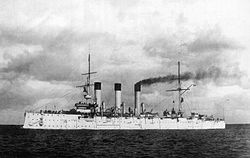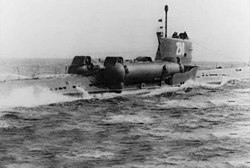Soviet Navy
| Soviet Armed Forces |
|---|
 |
| Components |
| Ranks of the Soviet Military |
| History of the Soviet Military |
| Navies of Russia |
|---|
The Soviet Navy (Russian: Военно-морской флот СССР, Voyenno-morskoy flot SSSR, literally "Naval military forces of the USSR") was the naval arm of the Soviet armed forces. Often referred to as the Red Fleet, the Soviet Navy would have been instrumental in any perceived Warsaw Pact role in an all-out war with NATO when it would have to stop the naval convoys bringing reinforcements over the Atlantic to the Western European theatre. Such a conflict never occurred, but the Soviet Navy still saw considerable action during the Cold War. The Soviet Navy was divided into several major fleets: Northern Fleet, the Pacific Ocean Fleet, the Black Sea Fleet, and the Baltic Fleet. The Caspian Flotilla was a semi-independent formation administratively under the Black Sea Fleet command while the Soviet Indian Ocean Squadron drew its units from and was under the jurisdiction of the Pacific Ocean Fleet. Other components included the Naval Aviation, Naval Infantry (the Soviet equivalent of marines) and coastal artillery. The Soviet Navy was reformed into the Russian Navy after the end of the Cold War in 1991.
History
This article's factual accuracy is disputed. |
Russians have not had a strong maritime tradition, at least in the same sense that other European powers such as the British and French enjoyed. Largely due to geography, Russia simply did not have the same amount of access to the high seas, and what access the nation did have was often constrained by seasonal ice. In addition, Russia's vast size and central placement on Eurasia allowed overland trade routes to many neighbors, thus negating the necessity of a navy to protect seaborne trade.


Early history
The Soviet Navy was formed in 1917 out of the ashes of the Imperial Russian Navy. Many vessels continued to serve after the October Revolution, albeit under different names. In fact, the first ship of the Soviet Navy could be considered to be the rebellious Imperial Russian cruiser Aurora, whose crew joined the bolsheviks. A previous bolshevik uprising in the fleet had occurred in 1905 involving Potemkin, an Imperial Russian battleship.

The Soviet Navy, then referred to as the "Workers' and Peasants' Red Fleet" (Russian: Рабоче-Крестьянский Красный флот, Raboche-Krest'yansky Krasny Flot or RKKF) existed in a dilapidated state during the interwar years, possessing a few obsolescent battleships but no aircraft carriers. As the country's attentions were largely directed internally, the Navy did not see much in the way of funding or training. A telling indicator of the perceived threat of the Navy was that the Soviets were not invited to participate in the Washington Naval Treaty, which served to limit the size and capabilities of the most powerful navies.
However, in the 1930s, as the industrialization of the Soviet Union proceeded, plans were made to expand the Soviet Navy into one of the most powerful in the world. This force was to be build around a core of powerful Sovetsky Soyuz class battleships. This building program was in its initial stages by the time the German invasion in 1941 forced its suspension.
The Great Patriotic War
The Winter War in 1939 saw some minor action on the Baltic Sea, limited mainly to artillery duels between Finnish forts and Soviet cruisers and battleships.
Only when Adolf Hitler launched Operation Barbarossa in 1941, did the Soviets realize the importance of the Navy. Much of the Soviet Navy during World War II was comprised of ex-U.S. Navy Lend-Lease destroyers.[citation needed] They were critical in defending convoys from Kriegsmarine U-boats. Unfortunately for the Soviets, much of their fleet on the Baltic Sea was blocked in Leningrad and Kronstadt by Finnish and German minefields during 1941–1944 and heavily maimed by mines and air attacks. Some units survived on the Black Sea, defending Sevastopol against siege.
Cold War

After the war, the Soviets concluded that they must be able to compete with the West at all costs. They embarked upon a program to match the West, if not qualitatively, then at least quantitatively. Soviet shipbuilding kept yards busy constructing submarines based upon World War II Kriegsmarine designs, and were launched with great frequency in the immediate post-war years. Afterwards, through a combination of indigenous research and technology obtained through espionage from Nazi Germany and the Western nations, the Soviets gradually improved their submarine designs, though initially lagging a generation behind NATO countries.
The Soviets quickly caught up with their western counterparts. The Soviets were quick to equip their surface fleet with missiles of various sorts. In fact, it became a hallmark of Soviet design to place gigantic missiles onto relatively small, and fast, missile boats. By contrast, in the West, such a move would never have been considered tactically feasible. Nevertheless the Soviet Navy also possessed several very large guided missile cruisers with awesome firepower, such as those of the Kirov class and the Slava class cruisers. Some of their submarines were considered superior to their American rivals.
Carriers and Aviation
The Soviet Navy generally placed less importance on aircraft carriers than their American rivals, however, it was felt that a carrier force of some form was needed.
In 1968 and 1969 the Soviet helicopter carriers Moskva and Leningrad appeared, followed by the first of four aircraft carriers of the Kiev class in 1973. Both of these classes were capable only of operating helicopters and/or VSTOL aircraft (Yak-38 Forger), and are thought to have been designed to operate primarily within range of land-based Soviet Naval Aviation aircraft.
In the 1970s the Soviets undertook Project OREL with the stated purpose of creating a supercarrier capable of compteting against American equivalents. However, the project was cancelled while still on the drawing board when strategic priorities shifted once more.
In the 1980s the Soviet Navy acquired its first true aircraft carrier, Tbilisi (subsequently renamed Admiral Kuznetsov). A distinctive feature of Soviet carriers is their offensive missile armament (as well as a long-range AAW suite), reflecting an operational concept which placed less emphasis on escort vessels, compared with Western carrier operations.
In the late half of the 1980s, the Soviet Navy again began the construction of a supercarrier, Ulyanovsk. Though the vessel neared completion, the end of the Cold War and a major funding crunch ended the project. The incomplete Ulyanovsk hulk was later sold for scrap.
In part to fill the role of aircarft carriers, the Soviet Navy deployed large numbers of strategic bombers in a maritime role, as part of Aviatsiya Voenno-Morskogo Flota (AV-MF, or Naval Aviation). Strategic bombers such as the Tupolev Tu-16 'Badger' and Tu-22M 'Backfire' were deployed with high-speed anti-shipping missiles. The primary role of these aircraft was the interception of NATO supply convoys traveling the sea lines of communication between Europe and North America, and thus countering Operation REFORGER.
Submarines
In some respects, including speed and reactor technology Soviet submarines were, and remain, some of the world's best. Their primary shortcomings were insufficient noise dampening (American boats were quieter) and sonar technology. The Soviets possessed numerous purpose-built guided missile submarines, such as the Oscar class, as well as many ballistic missile submarines and attack submarines. The Soviet navy's Typhoon class boats are the world's largest submarines. The Soviet attack submarine force was, like the rest of the navy, geared towards the interception of NATO convoys, but also targeted American aircraft carrier battle groups.
Over the years, Soviet submarines suffered a number of accidents, most notably on several nuclear boats. The most famous incidents include the K-219, and Komsomolets, both lost to fire; and the far more menacing nuclear reactor leak on the K-19. Inadequate nuclear safety, poor damage control and quality control issues during construction (particularly on earlier submarines) were typical causes for accidents. On several occasions, mishaps were alleged to have stemmed from collisions with American submarines. This however has not been confirmed officially by the United States Navy, which maintains a policy of secrecy regarding nuclear incidents.
Because of its "safety in numbers" philosophy, the Soviet Navy continued to operate many first-generation missile submarines, until the end of the Cold War in 1991. It was feared that in a time of war, Western submarines would be able to destroy many of their Soviet counterparts before they could launch. Questions regarding targeting precision may also have affected this decision. [citation needed]
The end
After the fall of the Soviet Union and the end of the Cold War, the Soviet Navy went neglected once again, and was eventually divided among several former Soviet republics. The Black Sea Fleet, in particular, spent several years in limbo before an agreement was reached to divide it between Russia and Ukraine.
Commanders-in-Chief of the Soviet Naval Forces
- Vasili Mikhailovich Altfater (October, 1918 — April, 1919)
- Yevgeny Andreyevich Berens (May, 1919 — February, 1920)
- Aleksandr Vasiliyevich Nemits (February, 1920 — December, 1921)
- Eduard Samoilovich Pantserzhansky (December, 1921 — December, 1924)
- Vyacheslav Ivanovich Zof (December, 1924 — August, 1926)
- Romuald Adamovich Muklevich (August, 1926 — July, 1931)
- Vladimir Mitrofanovich Orlov (July, 1931 — July, 1937)
- Mikhail Vladimirovich Viktorov (August, 1937 — January, 1938)
- Pyotr Andreyevich Smirnov (January — August, 1938)
- Mikhail Petrovich Frinovsky (September, 1938 — April, 1939)
- Nikolai Gerasimovich Kuznetsov (April, 1939 — January, 1947)
- Ivan Stepanovich Yumashev (January, 1947 — July, 1951)
- Nikolai Gerasimovich Kuznetsov - (July, 1951 — January, 1956), second term
- Sergey Georgyevich Gorshkov - (January, 1956 - December, 1985). Considered the officer most responsible for reforming the Soviet Navy
- Vladimir Nikolayevich Chernavin - (1985 - 1992)
See also
References
- Sontag, Sherry; Drew, Christopher; Drew, Annette Lawrence (1998). Blind Man's Bluff: The Untold Story of American Submarine Espionage. Harper. ISBN 0-06-103004-X.
- Nilsen, Thomas; Kudrik, Igor; Nikitin, Aleksandr (1996). Report 2:1996: The Russian Northern Fleet. Oslo/St.Petersburg: Bellona Foundation. ISBN 82-993138-5-6. Chapter 8, "Nuclear submarine accidents".
- Oberg, James (1988). Uncovering Soviet Disasters. New York, NY: Random House. ISBN 0394560957.
- Goldstein, Lyle; Zhukov, Yuri (2004). A Tale of Two Fleets: A Russian Perspective on the 1973 Naval Standoff in the Mediterranean. Naval War College Review.
- Goldstein, Lyle; John Hattendorf; Zhukov, Yuri. (2005) The Cold War at Sea : An International Appraisal. Journal of Strategic Studies. ISSN: 0140-2390
